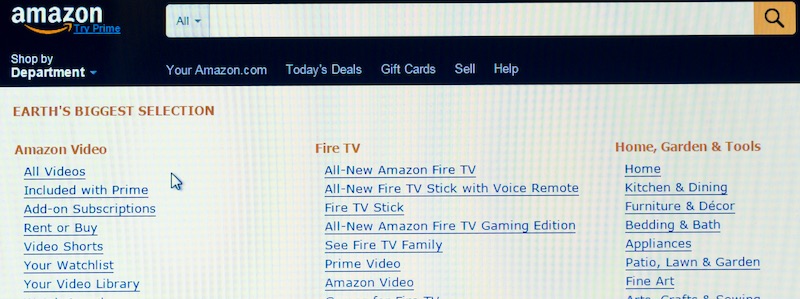
Without compelling content, it’s nearly impossible to be successful in ecommerce. Amazon excels in content creation, including taxonomy and navigation.
Your online store offers a good user experience and an attractive visual design. You know your target customers and how to reach them. Your pricing and promotions are competitive. What could go wrong?
You could fail to deliver the content your prospects are looking for when they are searching for products and making their buying decisions.
As I work with clients to improve conversion rates, average order values, and market share, content strategy becomes critical. In this post, I’ll describe the benefits (and challenges) of compelling content.
Content Strategy
With an effective content strategy, your customers and prospects can:
- Find your store, which you’ve optimized for search engines.
- Understand your brand story. It’s important to differentiate your brand and develop content to support your messaging and voice.
- Desire the products you sell. Once visitors land on your site, content will help them visualize using your products. Lifestyle and product stories are a good way to accelerate purchasing cycles.
- Find products quickly and efficiently. Thoughtful taxonomy for product categories, navigation, and site search will help your visitors quickly find the products they are looking for.
- Find the content they are looking for. Shoppers want product details — rich images, video, descriptions, specifications, comparisons. They also want supporting information about categories of products, featured and new products, and promotional offers.
- Find personalized, relevant content. Delivering relevant, timely content and offers that are personalized to visitors based on what you know about them and their onsite behaviors will help them focus.
- Easily compare products. Well-structured and consistent product content allows for comparison tools and rich, faceted search — all to help visitors quickly find products.
- Read user-generated content, to support decisions by learning what other buyers think of the products.
- See reinforcing content in marketing campaigns and social channels. Create social and email-nurturing campaigns to support your buyer’s journey. This is especially important for products with a long buying cycle.
What Is Content?
Content is anything that appears in your online store: product data, descriptions and images, brand stories, user-generated info, title tags and other metadata, and taxonomy and navigation. For inspiration, look to Amazon. It excels in nearly all aspects of content creation.
- Product content includes part numbers, short and long descriptions, specifications, images, videos, material safety data sheets, and instruction manuals. All of that should be structured and consistent. Some level of original content is crucial. It’s acceptable to reuse manufacturers’ specifications. But create original descriptions, your own part numbers, and unique images and videos. User-generated and expert content is almost mandatory today as shoppers look for validation from third parties. Creating original, compelling content will also help your site stand out on search engines.
- Marketing content. Hero images, promotions, seasonal collections and descriptions, category overviews and introductions, blogs, and informational pages: All are examples of marketing content. It should be refreshed regularly to keep your visitors engaged and provide a reason to return.
- Brand stories are conveyed in the site’s visual design, in lifestyle and product stories, and with your product content. Consistency is key. If you sell luxury products for a specific lifestyle, your product content should re-enforce that story. Similarly, if your brand is humorous and fun, make sure your imagery and descriptions reflect it.
- Lifestyle and product stories. If you are targeting lifestyle segments, the imagery and storytelling in your store should support that lifestyle. Closely aligned are product stories that include customers. Lifestyle segments are more than luxury and premium items. Sports, clothing, tech products, and gaming are all potential segments. They are easy stories to produce and well worth the time to create and repurpose in your social media, blogs, and advertising. They also bring value for SEO.
- Taxonomy. The way you organize your product categories greatly influences your shoppers’ ability to find products quickly. As you add new product lines, review your taxonomy and how it is presented. Taxonomy also involves defining the metadata for your pages — title tags, meta descriptions, structured markup. It includes defining your navigation — primary and secondary. Adding attributes to support filtering helps shoppers find products, brands, and categories.
Content is arguably the most challenging part of operating an online store. It requires nonstop creating, updating, adding, and removing. Without a compelling content strategy, it’s nearly impossible to be successful.
Challenges
Here are the main challenges to an effective content strategy, in my experience.
- Planning. Develop a plan for how content will be used, created, and maintained on your digital properties and in social channels. This frequently involves hiring an agency or a content expert.
- Creating and curating requires writers and subject-matter experts for articles, snippets, descriptions, and so forth
- Content migration. Moving content — from old to new sites and from manufacturers’ sites to yours — is a major undertaking that is typically underestimated. Before changing platforms, thoroughly evaluate what is involved in migrating content
- Consistency is always a challenge when there are multiple authors.
- Governance. Global companies that seek localized content must adhere to rules and approvals and must otherwise ensure the content is consistent and representative of their brand.
- Promotional content usually ends up throughout your website, digital campaigns, and social sites. Make sure to turn content off and replace it as campaigns expire.
- Taxonomy is crucial. It can also be complicated. Consider hiring a consultant for advice and direction.




